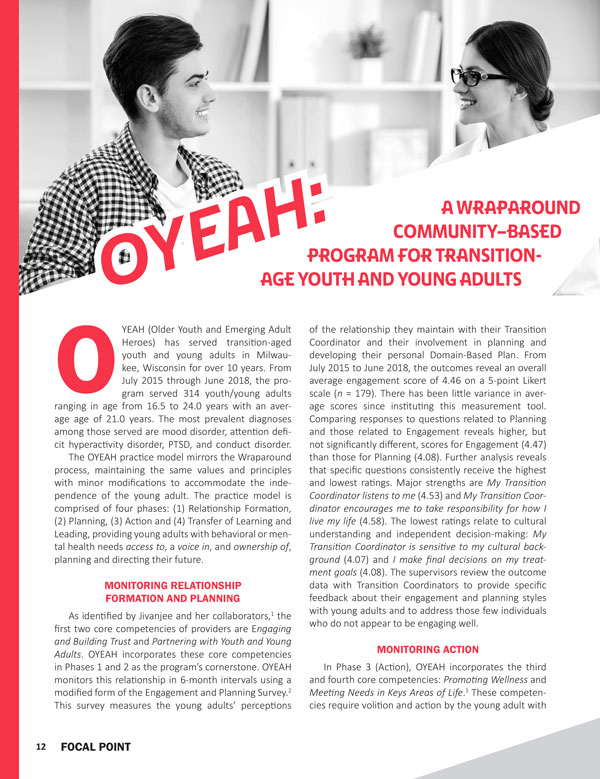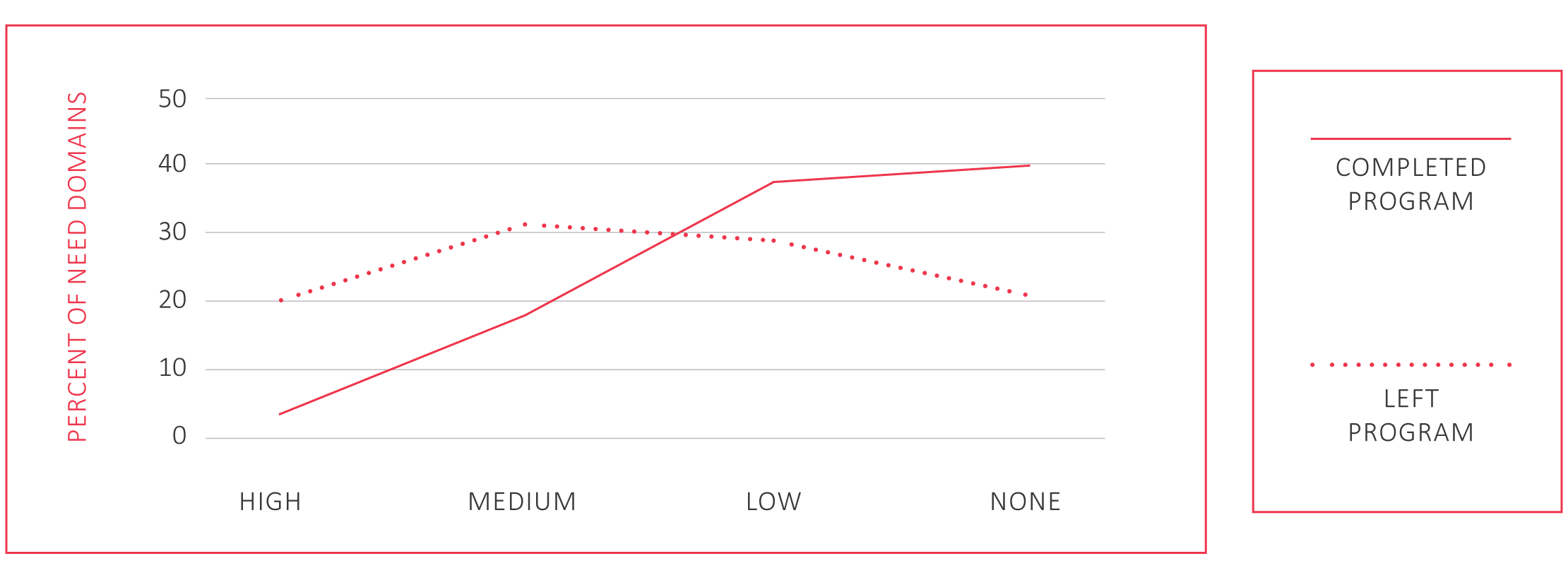
Abstract: In this article, authors describe how Milwaukee’s OYEAH program uses provider core competencies as a structure to help monitor the effectiveness of its Wraparound-based model for youth and young adults.
"OYEAH: A Wraparound Community-Based Program for Transition-Age Youth and Young Adults" (2019)
Pnina Goldfarb
OYEAH (Older Youth and Emerging Adult Heroes) has served transition-aged youth and young adults in Milwaukee, Wisconsin for over 10 years. From July 2015 through June 2018, the program served 314 youth/young adults ranging in age from 16.5 to 24.0 years with an average age of 21.0 years. The most prevalent diagnoses among those served are mood disorder, attention deficit hyperactivity disorder, PTSD, and conduct disorder.
The OYEAH practice model mirrors the Wraparound process, maintaining the same values and principles with minor modifications to accommodate the independence of the young adult. The practice model is comprised of four phases: (1) Relationship Formation, (2) Planning, (3) Action and (4) Transfer of Learning and Leading, providing young adults with behavioral or mental health needs access to, a voice in, and ownership of, planning and directing their future.
Monitoring Relationship Formation and Planning
As identified by Jivanjee and her collaborators,1 the first two core competencies of providers are Engaging and Building Trust and Partnering with Youth and Young Adults. OYEAH incorporates these core competencies in Phases 1 and 2 as the program's cornerstone. OYEAH monitors this relationship in 6-month intervals using a modified form of the Engagement and Planning Survey.2 This survey measures the young adults' perceptions of the relationship they maintain with their Transition Coordinator and their involvement in planning and developing their personal Domain-Based Plan. From July 2015 to June 2018, the outcomes reveal an overall average engagement score of 4.46 on a 5-point Likert scale (n = 179). There has been little variance in average scores since instituting this measurement tool. Comparing responses to questions related to Planning and those related to Engagement reveals higher, but not significantly different, scores for Engagement (4.47) than those for Planning (4.08). Further analysis reveals that specific questions consistently receive the highest and lowest ratings. Major strengths are My Transition Coordinator listens to me (4.53) and My Transition Coordinator encourages me to take responsibility for how I live my life (4.58). The lowest ratings relate to cultural understanding and independent decision-making: My Transition Coordinator is sensitive to my cultural background (4.07) and I make final decisions on my treatment goals (4.08). The supervisors review the outcome data with Transition Coordinators to provide specific feedback about their engagement and planning styles with young adults and to address those few individuals who do not appear to be engaging well.
Monitoring Action
In Phase 3 (Action), OYEAH incorporates the third and fourth core competencies: Promoting Wellness and Meeting Needs in Keys Areas of Life.1 These competencies require volition and action by the young adult with ongoing support of the Transition Coordinator, providers, and other team members. Organized around 10 developmental domains, young adults determine their priority needs.
Upon leaving the program, three factors of the Disenrollment Level of Progress are calculated: (1) Completing the Program, (2) the Youth Disenrollment Progress Report Score, and (3) the Needs Met per the Final Domain-Based Plan. The average score for young adults who either completed the program, or have chosen to leave the program after at least one year, is 59/100. While OYEAH's processes supporting transition are well established, implementing them can be challenging.
There are two domains that young adults must view as priorities and be motivated to address: Mental Health, focusing on emotional stability; and Transition to Adulthood, focusing on skill development. Challenges in their living situation frequently distract them from implementing their plans. Comparing the level of need (high need – no need) across all 10 domains of young adults who completed the program to those who have chosen to leave reveals a greater intensity of need across the domains for those that chose to leave (see Figure 1).
Figure 1. Domain Rating of Total Needs

The duration of time in the program of those who chose to leave ranges from 2 to 28 months with an average stay of 18 months. The combination of so many high to medium needs in key domains (mental health, employment, education, and living situation) may appear insurmountable to the young person and could result in emotional despair, possible homelessness, and disenrollment. However, among the young adults who have enrolled in OYEAH from the onset of the program (2009), 5% (38/713) have re-enrolled, which suggests that each young adult has his/her own process and some feel sufficiently comfortable to return when they are ready.
Monitoring Transfer of Learning and Leading
The fifth core competency, Facilitating Young People's Empowerment to Take Charge of their Own Wellness1 is incorporated into the fourth phase of the OYEAH Practice Model. Change in progress across time is monitored every six months using the Domain Appraisal Tool (DAT; adapted from National Outcome Measures, 2010)3 for all youth who have formally left the program, either by completion or by choosing to disenroll.
According to the DAT outcomes, the greatest change attributed to the young adult's participation in OYEAH is in the positive change in Internal Feelings about oneself, which shows an average increase of 27%. This was substantiated through interviews with six young adults who had completed the program in which they all expressed feeling more confident, less anxious, and more worthy. When asked what animal represented them as an adult, 100% of them independently reported a lion because "a lion is adaptable, a leader, and powerful." Improvement in their Everyday Living situation including work, school, family relations, and especially housing also contributed to feeling better, with an average improvement of 8.1%. In interviews, all young adults expressed concerns with housing. They talked about their struggle while in OYEAH to obtain housing, and its tenuousness. They understood the connection between education/training, employment, and having a safe place to live. One young adult reported, "It's all grouped together and it's like pulling a string from a sweater… It can fall apart."
Social Connectedness is the most challenging area when functioning independently without the ongoing supportive interactions that OYEAH provides (percent of change -5%). In addition, support from family ebbs and flows and therefore, no generalization can be made, as each situation is unique. The sense of feeling a part of a greater community is hard to achieve.
Lastly, monitoring negative symptoms (hospitalization and incarceration) provides additional indicators of how well young adults are functioning in the program. According to the Wisconsin Office of Children's Mental Health Annual Report (2017),4 the number of teens admitted on an Emergency Detention to a State run mental health facility increased from 350 to close to 800 from 2011 to 2016. Furthermore, the young adult (19-25) admissions have doubled in the last three years (250 to 500 per year). For young adults in OYEAH, the average rate of hospitalization from July 2015 to June 2018 was only 4% (14/314).
The Wisconsin Department of Corrections-Division of Juvenile Corrections (2015)5,6 recently reported the statewide recidivism rate is at 61% and the re-incarceration rate in the adult population is 15%. The state's general incarcerated population's demographics are 61% African American and 62% have mental health issues. While OYEAH's young adults all have mental health challenges and have a similar racial profile, from July 2015 to June 2018, only 8% (25/314) of program participants were incarcerated.
Young adults served by OYEAH have low rates of hospitalization and incarceration in a state with increasing rates of hospitalization for youth and young adults and high rates of recidivism. In addition, the program instills in young adults a greater sense of empowerment, self-esteem, and confidence. This process is summed up by the voices of the Transition Coordinators and the young adults who both reported "finding and believing in oneself" to be the most challenging obstacle to independence. Young adults stated that they received the most significant help in addressing these feelings of inadequacy. As reported by a Transition Coordinator, success is measured not solely by the completion of goals but rather "how resilient (they are) and how often the young adult comes back to try again." OYEAH, in partnership with young adults, builds the foundation that supports and provides direction to the desired goals.
References
- Jivanjee, P., Brennan, E., Grover, L., Sellmaier, C., Roser, E., Pathways Transition Training Collaborative, Youth M.O.V.E. National, & Pathways Transition Partners. (2018). Transition mental health service provider core competencies. Portland, OR: Research and Training Center for Pathways to Positive Futures, Portland State University.
- Walker, J. S., & Powers, L. E. (2007). Introduction to the Youth Self-efficacy Scale/Mental Health and the Youth Participation in Planning Scale. Portland, OR: Research and Training Center on Family Support and Children's Mental Health, Portland State University.
- Substance Abuse and Mental Health Services Administration, US Department of Health & Human Services. (2010). National Outcome Measures. Retrieved from https://www.samhsa.gov/grants/gpra-measurement-tools
- Wisconsin Office of Children's Mental Health. (2017). FACT SHEET: Youth psychiatric hospitalizations, readmissions, and emergency detentions. Madison, WI: Office of Children's Mental Health.
- State of Wisconsin Department of Corrections. (2016). Recidivism & re-incarceration. Retrieved from https://doc.wi.gov/Pages/DataResearch/DataAndReports.aspx
- State of Wisconsin Department of Corrections, Division of Juvenile Corrections. (2015). 2014 Annual Report. Madison, WI: Department of Corrections, Division of Juvenile Corrections.
Suggested Citation
Goldfarb, P. (2019). OYEAH: A Wraparound Community-Based Program for Transition-Age Youth and Young Adults. Focal Point: Youth, Young Adults, and Mental Health, 33, 12–14. Portland, OR: Research and Training Center for Pathways to Positive Futures, Portland State University.